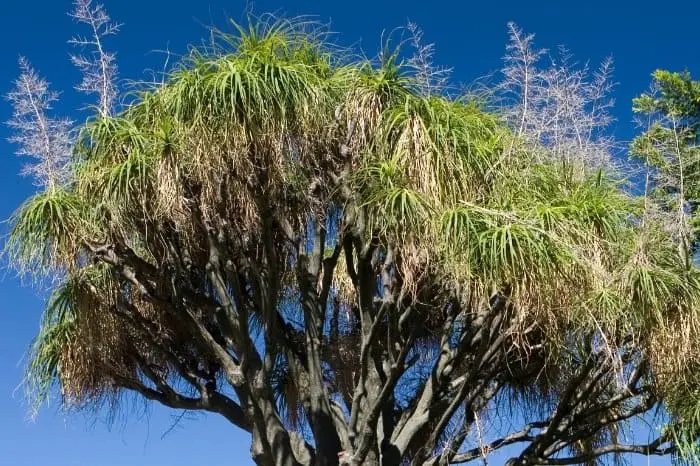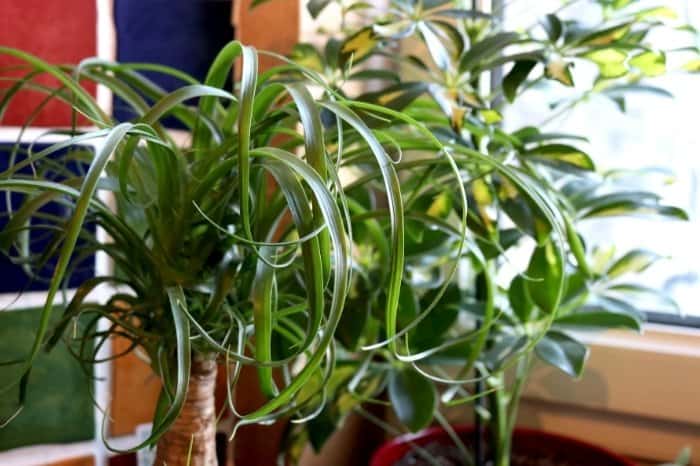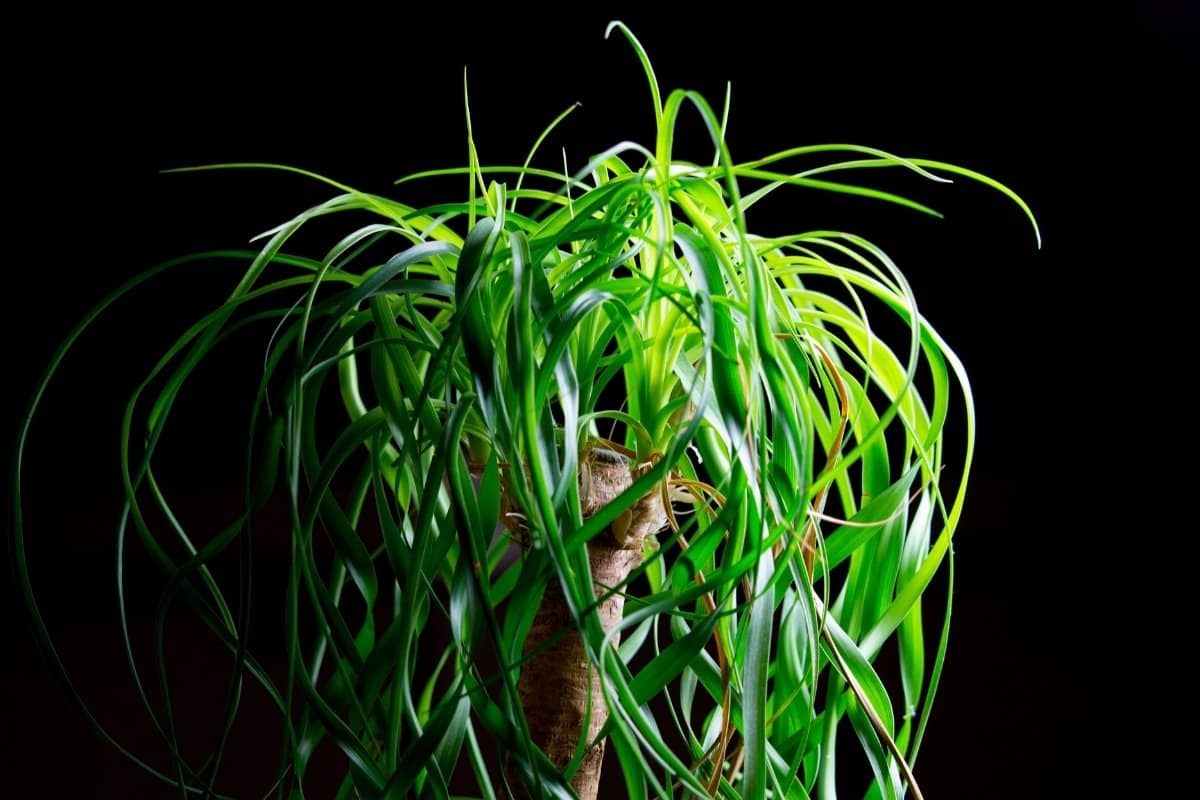Last Updated on March 2, 2023 by Griselda M.
Ponytail palm leaves turning brown can be quite concerning. Most plant owners have at least once faced the problem of ponytail palms with brown tips, a common occurrence with these plants. Luckily, this problem isn’t too difficult to solve, and you can still save your plant.
It’s important, however, to know how to prevent this problem, as well as know how to solve it! Whether your ponytail palm turned brown after repotting or through negligence, giving it the proper plant care and maintenance is essential to bring it back to its glory.
You don’t necessarily have to be an established gardener to implement ponytail palm plant care and maintenance strategies. All you need is the right information to aid you in growing healthy, thriving palm plants.
Ponytail Palm Brown Leaves
Developing brown leaves is one of the most common issues with ponytail palms! This usually means that you have left your plant without water for too long! So what to do when ponytail palm turns brown?
If your ponytail palm is dehydrated, its leaves will become brown and crunchy! This problem usually occurs because of improper watering. Ponytail palms don’t need water daily. They’re just fine being watered on a weekly or biweekly basis. However, this usually leads to the owner forgetting to water the palm on time, leading to dehydration.
There’s also the alternative problem to underwatering your ponytail palm, and that’s overwatering! If you overwater your plant, then the leaves will develop a yellow note, and they’ll start dropping. You can rest easy, however, as it’s not difficult to solve either of these problems!

Fixing Your Underwatered Ponytail Palm
You noticed that your ponytail palm is developing brown tips and you need to fix it! The first step is identifying whether the dehydration is minor or major.
1. Determining The Level Of Dehydration
Numerous signs are pointing you in the right direction regarding dehydration. If your dehydration is only minor, then the leaves will start to dry out and become brown. Ponytail palm care tips are essential to know in this case.
However, if your plant is suffering from major dehydration, you’ll also see that your leaves are drooping. The soil will become very dry, while the trunk can start wrinkling. This usually happens if you’re behind schedule on watering for weeks, while minor dehydration usually happens after a small delay in watering.
2.1. Fixing A Minor Dehydration
Fixing minor ponytail palm dehydration is simple and easy. The first step you should take is to clean the plant. To do this, you’ll need to trim all the brown tips. Experts recommend that you clean your scissors with alcohol between each cut. It’s also possible for a leaf to be completely or almost completely brown; cut the whole leaf off if this is the case.
You should look out for the number of leaves you’re cutting! Never remove more than 20% of affected leaves at once – do your cutting in stages. After that, all that’s left to do is to water the plant!
2.2. Fixing A Major Dehydration
Helping your ponytail palm plant after major dehydration is a bit more tricky than fixing minor dehydration. Follow the same instructions from the previous step, with additional instructions listed below.
After you’ve cleaned your ponytail palm plant, you’re going to have to rehydrate it.
Fill your tub with 4 inches of water before placing your plant inside without the saucer. This will allow the plant to drink up the water through the hole on the bottom! The water shouldn’t be hot for this, as that could harm the plant.
Soak your palm for at least 45 minutes before testing your soil. It should become softer – this means that the water has reached the topsoil. If that part of the soil is still dry, then hydrate the plant from the top. Once all the soil is properly soft and damp, allow the water to exit and let the plant drain. Once it’s mostly dry, you can put it back in its place.
Ponytail Palm Care
There are a few important things to keep in mind when you’re taking care of a ponytail palm.
Watering
Let’s talk about watering first. We spoke about overwatering and underwatering a ponytail palm which are two of the most common mistakes made with these plants. Ponytail palms need to dry out almost completely before watering, but they shouldn’t dehydrate! It’s best to water it once every two weeks, and you can even give it a few more days if you notice that it’s still not dry!
Blumat Classic Plant Watering Stakes | for Everyday Home or Vacation Use
Don’t confuse winter with summer, and make sure to adjust your watering accordingly. These plants don’t need as much water during the winter – it’s sometimes enough to water them once a month.
We recommend that you keep a watering schedule, so you don’t miss out!
Placement
It’s also important to keep placement in mind. Since this plant originated in eastern Mexico, it’s natural that it needs a lot of sunlight. The minimum requirement is 3-4 hours a day. It’s best to have it facing the southern or western side of your environment. Experts also recommend that you rotate it every few weeks, so all sides of the leaves get the same amount of sunlight.
Insufficient lighting can also cause problems with dehydration and expose your ponytail palm to develop brown tips! Some owners found that leaving the plant outside during the summer allows it to store excess energy to use during the winter when there’s less sunlight. However, make sure not to leave it out in the sun if it’s too hot, as that could dehydrate the plant quickly!
Potting And Fertilization
Since these plants are slow growers, you shouldn’t be bothered by their growth potential. You also don’t need to fertilize them more than once a month from spring to fall. Using organic houseplant fertilizer is just fine for these plants.
When you’re potting your plant, know that there’s a mixture of soil you can use to minimize dehydration. Mixing perlite, regular soil, and sand in an equal ratio will help you with watering. These plants also need to be repotted once every 12 to 18 months, depending on the size of the plant.

Ponytail Palm Brown Leaves Underneath – Reasons
When you see ponytail palm brown leaves underneath, there could be several reasons why this has occurred. When your ponytail palm plants are prioritizing water distribution, the leaves are the last to receive it, which results in them becoming brown. This is because the underside of leaves is not a priority when it comes to the survival of the entirety of the palm plant, especially in periods of drought.
What is important is the ponytail palms’ central tissue that needs to be hydrated at all times. Stressed or overwatered ponytail parts also manifest themselves by the appearance of browned leaves. This is when you would notice the underneath of your palm leaves starting to show a yellowing appearance which eventually turns to an eyesore brown color. Other factors that may contribute to this flaw include soil moisture problems caused by unfavorable atmospheric conditions.
These include light, temperature, humidity, and the excessive use of fertilizers, which can also be blamed for damaged foliage. Additionally, it is important to inspect your ponytail palm plant for insect infestations that deteriorate its growth habit.
Ponytail Palm Bottom Leaves Turning Brown – Best Tips
The unfortunate occurrence of ponytail palm bottom leaves turning brown will need urgent care and maintenance. Although flawed leaves would need to be discarded, neglecting them can deteriorate your plant substantially. However, all is not lost because if you know the steps to take to bring your ponytail palms back to health, then they would be thriving in no time. Listed below are a few tips that will aid you in growing healthy and happy ponytail palms with ease.
Ponytail palm plant care for browning leaves:
- If you see that your ponytail palm bottom leaves have turned brown, using a sanitized pair of garden sheers to prune the leaves would be best.
- It is important to follow a consistent watering schedule when growing ponytail palms. Too much or too little will results in browned leaves, so adjusting your schedule as needed is essential.
- Salt buildup in the soil is also another factor that discolors the bottom leaves of ponytail palm plants. In this case, watering the soil directly is advised to get rid of it.
- In some instances where the soil has an exorbitant saline presence. it is best to repot your ponytail palm to avoid further deterioration.
- If the damaged leaves are left untreated, they will eventually fall off, leaving you with a naked-looking palm.
- Stem and root rot are almost imminent when browned leaves are left untreated. For this reason, it is vital to cut them off.
- Ensure that your ponytail palm plants are planted in soil that is well-draining to keep them healthy. If planted in pots, drainage holes at the bottoms will be advised to get rid of excess water.
How Big Do Ponytail Palms Get
Ever wondered how big ponytail palms get? These plants are succulents by nature and grow best in Central America, which is their native environment. A fully grown ponytail palm that is given the proper care and maintenance is known to reach heights of 30 feet tall when grown outdoors. However, container-grown varieties have a much shorter height.
But, if you want to keep its stumped growth, then repotting into a larger pot is not advised. If not, then you can transplant your ponytail palm into a spacious container and watch how it enhances in size. Although, you must remember that these plants are slow growers and need time to fully develop.
A three feet height can be expected for indoor ponytail palms, while you can expect them to grow twice as much if transferred into larger containers and grown outdoors. Make sure to keep an eye out for ponytail palm leaves turning brown, and use the information above to treat your plant promptly.
How to Make Ponytail Palm Grow Taller
So, you want to know how to make your ponytail palm grow taller? If you are growing your plant indoors, you can expect it to advance to about two to four inches yearly. Outdoor ponytail palms, on the other hand, have much more rapid growth capabilities and can enhance in height by more than twelve inches in a year.
But there are a few things that you can do to make your ponytail plant grow taller. Proper care and maintenance will be the first step in encouraging your ponytail palms’ capabilities when growing. Negligence will have your ponytail palm leaves turning brown which can be an eyesore.
Take heed of the tips below to enhance the growth of your ponytail palm:
– Transferring your palm plant into a larger pot will prove fruitful in advancing its height.
– Much-needed nutrients, oxygen, and moisture can be acquired if the ponytail plant roots are given ample space to spread out in search of these components. This can be achieved with plants that are mostly grown directly in the ground as roots delve deep to extract additional nutritional elements.
– Pruning is an important part of ponytail palm care. Although this is not necessary with house-grown plants, outdone varieties would benefit from a good morning as it will stimulate the growth of additional trunks and advance the palm’s height. Pruning will also result in re-sprouting your ponytail palm.
– Ponytail palm leaves turning brown will also hinder the plants growing capabilities. Removing the flawed leaves is best to enhance growth.
Summary
To sum up, brown leaves on your ponytail palm are most likely the result of dehydration. Make sure to cut off the brown leaves and rehydrate your plant. To prevent this from happening again, start scheduling your watering. It’s best to water your plant once every two weeks and maybe even once a month during the winter, as mentioned above. Ponytail palms aren’t too sensitive, but they require a specific watering schedule and enough sun to reach their full potential and stay healthy. If you don’t overwater or underwater it, your plant should be just fine!



